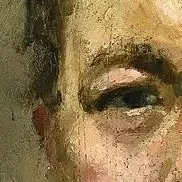Pinchon executed this work in a Post-Impressionist style with a subdued Fauve or Neo-Impressionist palette of golden yellows and incandescent blues. The dynamic image of the train in Pinchon’s painting is an homage to the emerging industrialized world.
The first railway station of Rouen was built on the left bank in 1843. The government authorized the continuation of the line to Le Havre and Dieppe the same year. It was therefore decided to build a bridge to the end of the Brouilly island (now connected to the Lacroix island), leading to the tunnel under the Côte Sainte-Catherine. The bridge, located in the Rouen metropolitan area, linking Paris and Le Havre, was named the English Bridge because many workers who built it were of English nationality. It is also called the Viaduc d’Eauplet, after the neighborhood where it is located.
The bridge originally consisted of wooden arches resting on piles of masonry. It was located a little further downstream than the existing bridge. It was inaugurated in 1847. A few months after its inauguration, in 1848, two arches on the side of the left bank were set on fire during a riot. It was then rebuilt. In 1856 the wooden arches were replaced by cast iron. This is the bridge that Pinchon painted. These arches proved fragile and it was decided to build a new bridge in 1912. Despite its destruction during the Second World War, the bridge completed and operational in 1914 is still used today.
https://en.wikipedia.org/wiki/Le_Pont_aux_Anglais,_soleil_couchant

